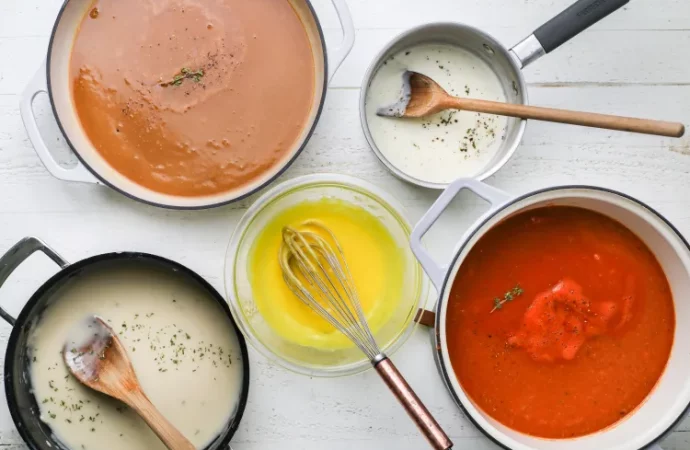Introduction When it comes to cooking, most of us start with the basics: salt, pepper, olive oil, and a handful of common herbs. These ingredients form the foundation of many dishes and are essential in any kitchen. However, once you’re comfortable in the kitchen, it’s time to expand your horizons and explore the world of
Introduction
When it comes to cooking, most of us start with the basics: salt, pepper, olive oil, and a handful of common herbs. These ingredients form the foundation of many dishes and are essential in any kitchen. However, once you’re comfortable in the kitchen, it’s time to expand your horizons and explore the world of ingredients beyond the basics. The beauty of cooking is that it offers endless opportunities to experiment, try new things, and elevate your meals to a whole new level.
In this article, we’ll explore ingredients beyond the basics—those unique flavors, spices, and techniques that can transform your dishes. From exotic spices to unusual fruits and culinary tools, we’ll dive into the ingredients that will elevate your cooking and inspire your next culinary adventure.
Expanding Your Spice Rack: Unique Spices and Flavorings
Spices are one of the easiest ways to introduce bold new flavors to your dishes. While most kitchens are stocked with basic spices like cumin, paprika, and garlic powder, there are many more that can transform your cooking. Let’s take a look at some unique spices that will expand your flavor palette.
1. Sumac
Sumac is a tangy, citrus-like spice often used in Middle Eastern and Mediterranean cuisines. Its vibrant red color adds a unique depth of flavor to meat dishes, salads, and even rice. If you love zesty and sour flavors, sumac is a must-try ingredient.
2. Za’atar
Za’atar is a Middle Eastern spice blend typically made from thyme, oregano, sesame seeds, and sumac. It’s earthy, herbal, and slightly tangy, making it a perfect topping for flatbreads, roasted vegetables, or even as a seasoning for chicken. Za’atar introduces a wonderful herbal and savory flavor that is unlike anything you’ll find in common spice mixes.
3. Turmeric
Turmeric is often associated with Indian cuisine, but it can be used in a wide variety of dishes. It has a warm, bitter flavor with an earthy aroma and is known for its health benefits, including anti-inflammatory properties. Adding turmeric to soups, curries, and even smoothies gives them a rich golden hue and a boost of flavor.
4. Saffron
Saffron is one of the most luxurious spices, prized for its unique flavor and vibrant color. It has a subtle, floral flavor that adds a delicate depth to rice dishes, seafood, and desserts. A little goes a long way, so a few strands are all you need to create a culinary masterpiece.
Beyond Herbs: Fresh Ingredients That Make a Difference
Herbs are essential for adding freshness and complexity to your dishes. While basil, parsley, and cilantro are common go-to herbs, there are many more that can elevate your meals with their distinct flavors.
1. Lemongrass
Lemongrass has a citrusy flavor with a mild, fresh aroma that adds brightness to dishes. It’s commonly used in Southeast Asian cooking, particularly in curries, soups, and stir-fries. Lemongrass works wonders in broths, giving them a fragrant, fresh note.
2. Kaffir Lime Leaves
Kaffir lime leaves have a distinct citrus flavor that is sharp and aromatic. They are commonly used in Thai and Indonesian cooking to infuse soups, curries, and stir-fries with a refreshing and aromatic lime essence. These leaves add a complex and bright note to dishes.
3. Fresh Ginger
Ginger is another herb that can go beyond just being a spice in your pantry. Fresh ginger adds a warm, slightly spicy flavor that works well in a variety of dishes, from savory curries to sweet desserts. It also has the ability to add a peppery kick and a touch of sweetness, depending on how you use it.
Fruits: From Sweet to Savory
Fruits aren’t just for desserts. Many fruits can also bring a surprising touch of flavor to savory dishes, adding sweetness, tanginess, and complexity that balance out rich, spicy, or savory components. Here are some fruits that go beyond the basics and will elevate your cooking.
1. Pomegranate
Pomegranate is a versatile fruit that adds a burst of sweetness and tartness. Its juicy seeds, called arils, can be scattered on salads, couscous, or roasted meats. Pomegranate’s vibrant red color and juicy texture create a stunning contrast in both flavor and presentation.
2. Mango
Mango is a tropical fruit known for its rich, sweet flavor. It’s commonly used in salsas, smoothies, and salads, but it also works wonders when paired with spicy or savory dishes. Mango chutney or mango salsa pairs perfectly with grilled meats and curries, adding a bright, tangy flavor that balances spiciness.
3. Avocado
While avocados are primarily known for their creamy texture, they also provide a mild nutty flavor that can complement both savory and sweet dishes. Use avocado in salads, as a spread on toast, or even in smoothies for an extra dose of creaminess and healthy fats.
The Role of Special Cooking Techniques
In addition to exotic ingredients, special cooking techniques can take your meals from good to great. Here are some culinary methods that go beyond the basics and can elevate your dishes.
1. Sous-Vide Cooking
Sous-vide is a cooking method where food is placed in vacuum-sealed bags and then cooked in a low-temperature water bath for hours. This technique results in perfectly tender meats and flavorful vegetables that retain their nutrients and textures. Sous-vide is ideal for preparing meats like steak, chicken, or fish, and is gaining popularity in home kitchens.
2. Fermentation
Fermented foods have become more popular recently, but this ancient technique has been used for centuries. Fermented ingredients like kimchi, sauerkraut, and miso add depth, umami, and tanginess to dishes. Fermenting your own vegetables or creating homemade pickles can add a unique twist to your cooking.
3. Smoking
Smoking adds a rich, smoky flavor that can transform meats, vegetables, and even cheeses. Whether you’re using a traditional smoker or a stovetop smoking device, the process of infusing food with smoke can create a new level of complexity and excitement in your meals.
Conclusion
As cooking evolves, so does the potential for flavors, textures, and techniques to elevate the dishes we prepare. By experimenting with ingredients beyond the basics—like exotic spices, fresh herbs, and unique fruits—you can unlock new depths of flavor and transform your meals into something extraordinary.
Whether you’re looking to spice up your everyday cooking or venture into new culinary territories, expanding your ingredient list is the perfect way to inject excitement into your meals. By embracing new ingredients and cooking techniques, you’ll continually refine your culinary skills and develop a deeper appreciation for the art of cooking.
Incorporating new ingredients and methods not only enhances the flavor of your dishes but also opens the door to creative and adventurous cooking. So, next time you step into your kitchen, think beyond the basics and embrace the world of exciting new ingredients that can truly elevate your cooking.























Leave a Comment
Your email address will not be published. Required fields are marked with *